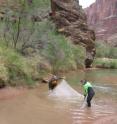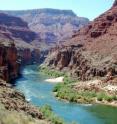Dams destabilize river food webs: Lessons from the Grand Canyon
Managing fish in human-altered rivers is a challenge because their food webs are sensitive to environmental disturbance. So reports a new study in the journal Ecological Monographs, based on an exhaustive three-year analysis of the Colorado River in Glen and Grand Canyons. Food webs are used to map feeding relationships. By describing the structure of these webs, scientists can predict how plants and animals living in an ecosystem will respond to change. Coauthor Dr. Emma Rosi-Marshall, an aquatic ecologist at the Cary Institute of Ecosystem Studies, comments, "Given the degraded state of the world's rivers, insight into food webs is essential to conserving endangered animals, improving water quality, and managing productive fisheries."
The project -- which relied on a team of more than 10 researchers from the Cary Institute of Ecosystem Studies, Montana State University, Idaho State University, University of Wyoming, U.S. Geological Survey, and Loyola University of Chicago -- assessed six sites on the Colorado River, many so remote they required two-week boat trips through the canyon.
Study sites were distributed along a 240-mile stretch downstream of Glen Canyon Dam, which was completed in 1963 for water delivery and hydroelectric power needs. During the three-year study, samples of over 3,600 animal diets and 4,200 invertebrate populations were collected and processed. Among the team's findings: following an experimental flood, sites near the dam had the most dramatic changes in the structure and function of their food webs.
Lead author Dr. Wyatt Cross of Montana State University comments, "Glen Canyon Dam has transformed the ecology of the Colorado River. Immediately downstream, cold, low-sediment waters have favored exotic plants and animals that haven't co-evolved with native species. We now see reduced biodiversity and novel species interactions that have led to the instability of these river food webs."
Near Glen Canyon Dam, the researchers found food webs dominated by invasive New Zealand mud snails and non-native rainbow trout, with large mismatches in the food web and only a small percentage of available invertebrates eaten by fish. In contrast, downstream food webs had more native fish species, and fewer invertebrates that were more efficiently consumed by fish, including a federally-listed endangered species, the humpback chub.
In March of 2008, the Department of Interior conducted an experiment that simulated pre-dam flood conditions, providing an opportunity to see how high flows affected food webs with very different characteristics. Rosi-Marshall explains, "Food web stability increased with distance from Glen Canyon Dam, with downstream sites near tributaries proving the most resistant. At these locations, the flood didn't cause major changes in the structure of food webs or the productivity of species."
It was a different picture for sites near the dam. As co-author Dr. Colden Baxter, an aquatic ecologist with Idaho State University, notes, "These energy inefficient, simplified food webs experienced a major restructuring following the experimental flood." New Zealand mudsnails were drastically reduced. And changes in algal communities led to a rise in midges and blackflies -- favored foods of trout -- resulting in a near tripling of non-native rainbow trout numbers.
Rainbow trout, introduced below Glen Canyon Dam in the 1960s, support a valued recreational fishery. But when trout density increases upstream, and fish move downstream into Grand Canyon, they can compete with native fishes for limited food resources, sometimes preying upon juveniles.
"Understanding how and why high flows affect trout numbers is valuable information that decision makers can use to help manage and protect river resources," remarks Dr. Theodore Kennedy, project coordinator and a coauthor of the study with the U.S. Geological Survey's Grand Canyon Monitoring and Research Center.
Dr. Robert Hall, an ecologist at the University of Wyoming, notes, "While downstream food webs proved to be more stable in our study, they are clearly a shadow of pre-dam conditions. Four large native fishes have already been lost from the Grand Canyon reach of the Colorado River. And invertebrates that were once an important part of the food web, such as mayflies and net-spinning caddisflies, are conspicuously absent."
Today, many ecosystems are like the Colorado River: an amalgam of native and non-native species living in human-altered habitat. The study's authors demonstrated that large-scale modifications, like dams, can have far-reaching effects on how energy flows through food webs, altering their stability and leading to less resilient ecosystems.
Cross concludes, "Looking to the future, we need to develop predictions about how disturbances spread through ecosystems, affecting the species or services upon which we depend, so we can implement proactive strategies."
This study is a product of the Glen Canyon Dam Adaptive Management Program, a collaborative initiative that supports scientific research in the Grand Canyon as an aid to decision making and management. The USGS Grand Canyon Monitoring and Research Center provides the scientific research and monitoring that informs the Bureau of Reclamation's management and operation of Glen Canyon Dam.
Source: Cary Institute of Ecosystem Studies
Other sources
- Dams destabilize river food webs: Lessons from the Grand Canyonfrom Science DailyTue, 20 Aug 2013, 17:00:21 UTC
- Dams destabilize river food webs: Lessons from the Grand Canyonfrom PhysorgTue, 20 Aug 2013, 13:01:35 UTC


